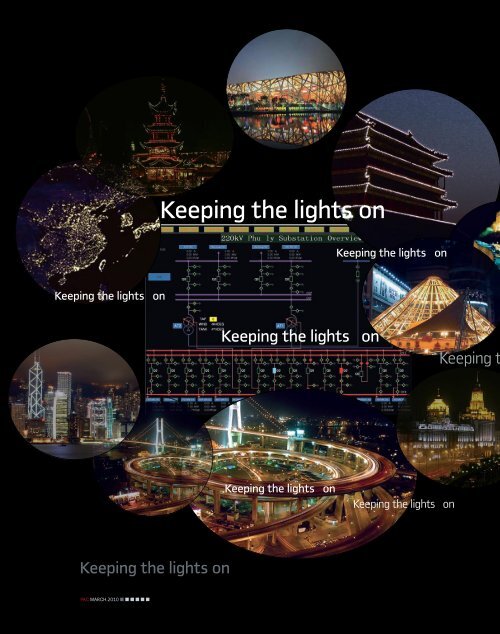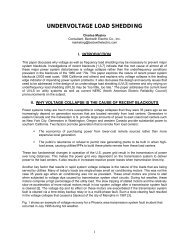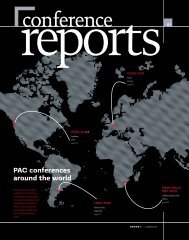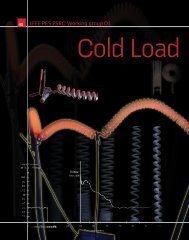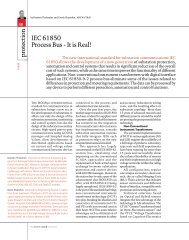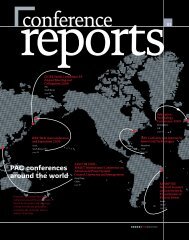PDF Version
PDF Version
PDF Version
- No tags were found...
You also want an ePaper? Increase the reach of your titles
YUMPU automatically turns print PDFs into web optimized ePapers that Google loves.
Keeping the lights onKeeping the lights onKeeping the lights onKeeping the lights onKeeping tKeeping the lights onKeeping the lights onKeeping the lights onPAC.MARCH.2010
y Xi-cai ZHAO, Shu-chao WANG, Shao-jun CHEN, NR Electric Co., China4647Data AcquisitionSCADAhe lights onin Substation for theFutureToday, almost everyone is talking about Smart Grid. However, data andinformation are the basis for the operating of the electric power system, and dataacquisition is the key issue. There are several independent systems betweensubstations and controlcenters : SCADA systemRelay Protection & FaultInformation ManagementSystem (PMIS) SpecialProtection Scheme (SPS)Wide Area MonitoringSystem (WAMS)Tele-metering system(TMS), etc.Each system is for a unique purpose and has its own data acquisitiondevices in the substation, dedicated communication channel between substationsand control centers, and dedicated processing workstation in control centers.Furthermore, each system is maintained by a separate team, thus the maintenanceof common system data models, parameters, and data itself is done repeatedly, andthere is inconsistency between these systems. With the application of electronicinstrument transformers and IEC 61850, it is possible to integrate these systems,optimize hardware configuration, re-allocate functions, unify data models and thecommunication interface, so as to share the power grid models, parameters, dataand other resources, make it easy to maintenance or add new functions, and saveinvestment. The roadmap to achieve a universal data acquisition platform proposedin this article includes the following steps:Update the conventional bay control unit to include functions of PhasorMeasurement Unit (PMU) and that of Disturbance & Fault Recorder (DFR)Update substation gateway interfaced with control centers to handle all thedata collected by substation automation systemsDesign a new communication protocol to transmit all kinds of data betweensubstations and control centers via a single communication channel (IEC61850-90-2 may be the answer)PAC.MARCH.2010
48SCADAData AcquisitionData acquisitionis the key issue.It is feasibleto re-designsubstationUpdate the front end terminals at control centers tohandle all the data for different purposesSet up a universal platform at control centers for dataacquisition, data sharing, data display, and variousapplications, which are part of smart EMS (EnergyManagement System)Reliability plays a significant part in the design processof a Universal Data Acquisition Platform, which should betaken into consideration during the hardware and softwaredesign of the whole system and can be achieved in fouraspects: redundancy, security, robustness and resilience.Data requirements for different purposeToday, there are several departments in control centerthat care about real time data from substations. In Chinathey are: Operating Operation Planning Market andTrading Protection Automation CommunicationDepartments.Other utilities may have different organizationstructure, but with similar functions. For operators onduty at control centers, the data or information shouldassist them to manage the entire system during steadystate, fault clearance period, and post-fault restoration.The data required for the monitoring and control of thepower system can be classified into three types:Real Time DataReal time data from the physical process, includingalarms, events, status, analogue measures of generation,load, flow, voltage, current, etc.Real time data generated by data processing and byoperator input, including derived values operatorcontrols/commands/comments, output of close-loopalgorithms, etc.Real time data imported from other informationsystems, e.g. from other SCADA nodes, from externalSCADA systems, etc.Historical/Archived DataLong term storage of selective real time data fortrending, analysis and planning purposesSemi-static DataData describing the physical processes such as powersystem topology, asset parameters, etc.Data supporting the processing functions such asconversion parameters, displays, etc.On the other hand, protection people want to uploadprotection parameters, fault recordings from substationsto do post-fault analysis, protection setting check andprotection performance evaluation. Recently, manyliteratures researched feasibility of system modeling, statemonitoring, state estimation, stability analysis, post-faultanalysis or even close-loop control for stability purposebased on data collected by PMUs. The requirements onrefreshing cycles and propagation delay of PMU data fordifferent purposes are shown in Table 1.Roadmap to achieve a Universal DataAcquisition PlatformThe main idea of a universal data acquisition platform isto merge the existing independent systems and at the sametime fulfill the various requirements on data acquisitionautomationsystem,networksbetweensubstations and1Existing systems between substations and control centerEMSPMISControl CenterAACSPSTMRcontrol centers,FEFEFEFEFEand automationsystem in thecontrol center,to have betterIEC 60870-5-101IEC 60870-5-104GatewayProprietary IEEE C37.118 Proprietary IEC 60870-5-102SubstationGateway PDC Gateway Gatewayprotection,monitoring andcontrol of theelectric powersystem.BCUPROTDFRPMUMETSCADA PMIS WAMS SPS TMRAAC Analysis and Application Center BCU Bay Control Unit DFR Disturbance & Fault RecorderEMS Energy Management System FE Front End MET MeterPDC Phasor Data Concentrator PMU Phasor Measurment Unit PROT ProtectionPMIS Relay Protection & Fault Information Management System SPS Special Protection Scheme TMR Tele-Metering Reading SystemSCADA Supervisory Control and Data Acquisition WMAS Wide Area Management SystemSPSPAC.MARCH.2010
y Xi-cai ZHAO, Shu-chao WANG, Shao-jun CHEN, NR Electric Co., Chinafrom system operation point of view. After investigatingthe existing systems, a roadmap has been proposed asshown in Figure 2.Update BCU: (Figure 2(A)). Update bay control unitas a universal bay control unit (UBCU). It integratesfunctions of conventional bay control unit (BCU), phasormeasuring unit (PMU), and dynamic and fault recorder(DFR), and it can sample data of steady state, dynamicstate and transient state. All the samples are time tagged.For traditional instrument transformers, differentsecondary coils are provided for different purposes,i.e. protection, measuring and tariff metering. Fornon-conventional instrument transformers, differentcommunication data channels are provided for differentpurposes, i.e. protection, measuring / metering, as definedin IEC 60044-8. The UBCU may adopt data of differentquality regarding steady state accuracy and transientperformance from instrument transformers. If processbus is applied, such a new design reduces the number ofsecondary equipments connected to process bus for adifferent purpose, thus reducing the load flow on processbus. Thanks to the development of micro-controllers andDSPs, there is no doubt that a bay control unit can handleall the data efficiently. The sample rate can be high enoughto process steady state, dynamic and transient data.Under normal condition, only time-tagged steady stateanalogue signals are sent at lower rate, for example onepackage per second. During a dynamic period, when alow frequency oscillation occurs, the event and oscillationfrequency are reported or the low frequency oscillation canbe detected in the control center, if the data sampling rateis high enough. When a fault occurs, the brief report willbe sent at first, and the total recording will be sent after therecovery from the fault for further analysis.Update Gateway: Update the gateway as a universalcommunication interface to the control centers (see Figure2(B)). Such a gateway can handle all the data collectedby substation automation systems, and transmit themto control centers: SCADA data, protection settingsand fault reports, fault recording, etc. At this stage, thecommunication channels are still separated betweennormal SCADA and other applications.As an optional solution, if it is not feasible to updateBCU at once as described earlier, the steady state samplewithout time tag received from BCUs can be time-taggedby the Gateway before being transmitted to the controlcentre. The inaccuracy of time synchronization of thissolution can be minimized by increasing the data refreshrate and decreasing propagation delay of communicationbetween BCUs and the Gateway.Another idea related to Gateway is to set up asubstation-level sub-database as a part of entire SCADAsystem. The raw data will be processed; the bad datawill be checked and corrected. Furthermore, part of stateestimation function can be completed at substation level,which is done in the control center today.Data and information are thebasis of the operation of theelectric power system.Update Tele-communication Facilities: Today, thewide area communication networks are available for allthe applications described in this article, for example,Synchronous Digital Hierarchy (SDH) and SynchronousOptical Networks (SONET) links in fiber optic networks.One obstacle to improving the efficient operation of theelectric power system is the number of communicationprotocols used. Today we have different standards fordifferent applications; some of them are still proprietaryones, as shown in Figure 1. Measured value with timetag can be transmitted via IEC 60870-5-101 or IEC60870-5-104, but this kind of ASDU (Application ServiceData Unit) is seldom used practically today.To transmit all kinds of data between substationsand control centers via a single communication channel,one solution may be IEC 61850-90-2: Using IEC 61850for the communication between substations and controlcenters. Whether or not this future standard can cover allthe applications is unknown yet.Update Front End Terminals: Figure 2(C) shows afront end terminal that handles all the data for a differentpurpose. Its function is almost the same as in the past.Update Data Collection Platform: The last step isto set up a universal data collection platform for dataacquisition, data processing, and data management atcontrol centers for various applications (Figure 2(D)). Thiscentralized solution leads to the controlled consistency ofredundant data, a high level of data integrity, standard datatypes and the sharing of common data.Control Center Organization and Workflow: Theorganizational structure of the control center is one mainfactor which leads to the fact that many independentsystems exist in parallel. Each department in the controlcenter only cares about the data they need. Once theyfeel it necessary, they will design a dedicated system withits own data acquisition devices in substation, dedicatedcommunication channels between substations and thecontrol center, and dedicated processing workstationstable 1 Requirements on:Refreshing Cycles and Propagation delay of PMU DataFunction in Control CenterRefreshingcycles(per sec.)Propagationdelay(sec.)Frequency monitoring 25-50 ≤ 1Reactive power & voltage monitoring 25-50 ≤ 1State estimation 25-50 SeveralModel & parameter verification 25-50 SeveralLow frequency oscillation monitoring 25-50 ≤ 1Stability assessment and emergency control 25-100 ≤ 0.149Xi-cai ZHAO- received hismaster degree fromElectrical EngineeringDepartment ofShanghai JiaotongUniversity (SJTU) in1997. From then on,he has been workingfor Nanjing NARI-RELAYS Electric Co.,Ltd (NR Electric).He was involvedin development ofdigital protectiverelays, bay controlunits, protocolconverters, specialprotection scheme,electronic instrumenttransformers,etc. Now, he is thedeputy chief engineerof NR Electric,Secretary Generalof Protection StudyCommittee ofChinese Society ofElectrical Engineering(CSEE), memberof Chinese Nationalstandard TechnicalCommittee of MeasuringRelays andProtection Equipments,Memberof IEC TC95 MT1,MT3 & MT4, andregular member ofCIGRE SC B5. E-mail:xczhao@nari-relays.comPAC.MARCH.2010
y Xi-cai ZHAO, Shu-chao WANG, Shao-jun CHEN, NR Electric Co., China50SCADAData AcquisitionShu-chaoWANGreceived his masterdegree from HuazhongUniversity ofScience and Technology(HUST) in2004. Since then hejoined NR Electricas a R&D engineer.He involved indevelopment of IEC61850 based digitalprotective relays,bay control unitsetc. Now he is alsoa member of CIGREWG B5.36. E-mail:wangsc@nari-relays.comin the control center. The seamless universal platformsolution may break the boundaries between them, andchange the way they work today.Redundancy and ReliabilityThe automation industry’s rapid movement towardcomputer controls has increased the importance ofreliability in data acquisition systems. Reliability playsa significant part in the design process of our UniversalData Acquisition Platform. According to IEC 60870-4,reliability is defined as a measure of the ability ofequipment or a system to perform its intended functionunder specified conditions for a specified period of time.The Universal Data Acquisition Platform shall continueto be operable, according to the “graceful degradation”principle described in "Distributed Control SystemReliability" by Emmanuel G. Diaz and Iliya A. Dormishev,as well as "Reliability investigations for SA communicationarchitectures based on IEC 61850" by Lars Andersson,Christoph Brunner. This principle should be valid if anycomponent of the data acquisition system fails, such as afailure in UBCU, gateway, FE or any of the above SCADAor other application computers. In Barry C. Ezell’s thesison vulnerabilities of the SCADA system, it is said that areliable system depends on its survivability. Survivabilityis a measure of how a system will function and recoverafter failure and is dependent on the system’s redundancy,security, robustness and resilience. For the Universal DataAcquisition Platform, these principles directly involve thehardware and software design of the whole system.Redundancy: Redundancy plays a crucial role inmaintaining high reliability of the whole Universal DataAcquisition Platform. Redundancy in a system “…refersto the ability of certain components of a system to assumefunctions of failed components without adversely affectingthe performance of the system itself”. Some events, such asdevice power off, network physical or logical disconnect,systems crash, can make the whole system out of service.Yet, these events are avoidable using redundant dataacquisition methods. For example, a redundant powersupply can take the UBCU unaffected when one powersupply is out of service. A hot standby redundant UBCUcan avoid data loss when the other UBCU crashes for anunknown reason. What’s more, the physical topologyof the system network connections must supportredundancy, and the network software must be intelligentenough to recover from various physical failures. On thesubstation side, a redundant station bus should also beadopted for redundant data acquisition of the UBCU. Bycombining these different redundancy methods, manyhybrid systems can be created.Security: Security deals with prevention, detectionand defence from internal and external attacks. If there isnothing preventing a hacker from breaking into SCADAnetworks, anyone with enough knowledge of computerscan disrupt communications, change program parameters,and eventually cause the system to malfunction. Therefore,Tariff metering needs to beseparate from the othersecondary equipment .it is important to design a system that provides protectionagainst unauthorized access to operator displays,control operations, database modification, and access toapplications and critical functions. With the introductionof the international security standard IEC 62351, arole based access control solution will be established tosafeguard the whole communication system. The rolebased access control can not only be applied to field deviceUBCU, gateway, but also to the whole data acquisitionplatform, consisting of field devices, station control andnetwork control – the complete pyramid, in order tosupport end to end security. This can secure the universaldata acquisition system against all kinds of cyber attacks,improving the reliability of the whole system especially incase of increasing network crimes.Robustness: The third principle of survivabilityinvolves a system’s robustness. It “…refers to the degreeof insensitivity of a system design to errors”. The UniversalData Acquisition system should be robust enough tomaintain all components, both software and hardware,functioning well to keep the system running after anattack or failure. And the function code implementedin the system should have the ability to function underabnormal conditions. Code in each of the networkcomponents can be wide-awake so that if there is a failurein communication, it will be detected and then a new setof rules are given to the system. The purpose of this setof rules is to keep the system stable under the presence offailure and increase failure tolerance.Resilience: “Resilience is the ability of a systemto operate close to its intended design, technically andinstitutionally, over a short time after the attack, suchthat the losses are within manageable limits”. Basicexamples of resilience to SCADA system are virusprotection programs. If the data acquisition systems haveconnections to the Internet, it runs the risk of having thesystem infected by a computer virus. The virus protectionsoftware is constantly searching through system files fora virus, and if found, destroying it before it corrupts anydata. In addition, if an attack is successful, a plan of actionhas to be in place so that system operators and technicianscan deal with the situation to bring the system backonline as soon as possible. In SCADA system, resilience isnormally limited to the code used to program the gatewayand UBCUs. The code has numerous checks between eachunit and the supervisor, which creates a set of alarms thatwill be displayed through the HMI. From here, operatorswould attempt to correct the errors, and return the systemto its normal operational mode.PAC.MARCH.2010
y Xi-cai ZHAO, Shu-chao WANG, Shao-jun CHEN, NR Electric Co., China5112Steps towards the universal solutionACSCADAFEGatewayControl CenterSubstationAPPFEGatewayUBCU (BCU + PMU + DFR)SCADAControl CenterFESubstationGatewayAPPUBCU (BCU + PMU + DFR)SCADAFEControl CenterSubstationGatewayAPPFEUBCU (BCU + PMU + DFR)Control CenterSCADA +APPFESubstationGatewayUBCU (BCU + PMU + DFR)APP Various applications UBCU Universal Bay Control Unit13 Substation overview 14The team work environmentBDShao-jun CHENbecame a protectiverelay engineerfor East ChinaPower GridCo. (ECPGC) in1983. Since 1989,he has been adepartment mangerof relayingprotection inECPGC, and had tenyears†professionalexperienceon powersystem operationand protection from1983 to 1992. From1993 to 1996, hewas achief and professionalengineer atGrid Control Centerin ECPGC beingresponsible forpower systemstability control. Hejoined in SchweitzerEngineeringLaboratories, Inc.(SEL) in 1996 andhas ten yearsâ€experiencedwith SEL onschematic design,project managementand technicalapplicationrespectively forinternationalcustomers, andbecame a RSM forEast Asia since2002. At present, hehas been workingfor NR Electric since2006 as a VicePresidentE-mail: sjchen@narirelays.com.PAC.MARCH.2010


